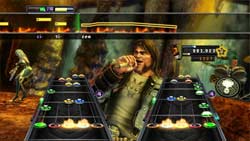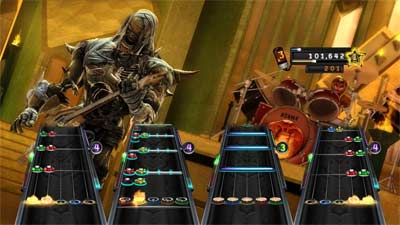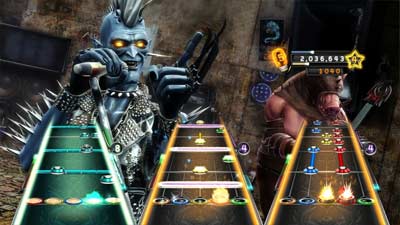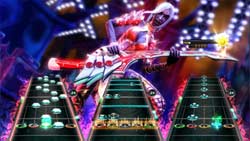A Hero Among Imitators?
Music games are the best interactive genre to be introduced to video games in the last decade. From dance titles like Dance Dance Revolution to strict karaoke titles like SingStar, music games capture a little of the dreamer in all of us. These titles give us the guts to sing at the top of our lungs and dance like there’s no one watching. Granted, this happens mostly inside the protection of our own home, but the games provide an outlet for a desire that has always been there. Of all the music titles, there is one that started a musical revolution. I am, of course, talking about Guitar Hero. Guitar Hero single-handedly invigorated not only the music industry but the desire for people to learn to play the guitar.

The success of the release of the first Guitar Hero came in the form of critical acclaim and knock-offs. It even sparked a band-centric, branch-off sub genre. Guitar Hero has since answered this with its own inclusion of band instruments. Of course after Guitar Hero 5’s numerous bad press pieces, fans began to wonder how Guitar Hero was going to reclaim its title as the genre leader in music games. With the new release of Guitar Hero: Warriors of Rock, did they accomplish this or is this a new Guitar Hero ready to be forgotten?
Most everyone has already heard about the game’s story. There’s an ancient battle amongst the rock gods, and players will become warriors of rock in order to restore balance and save rock n’ roll. This sounds familiar to the story of last year’s Brutal Legend. While there’s no denying this, Warriors of Rock uses this basis to do something in the Guitar Hero series I have long thought needed to be done. Give it a point. Yes, I understand most people only want to Quickplay and break their fingers while playing expert on every song available. But there is a certain level of satisfaction to be felt as you progress through the Quest unlocking both new songs and new characters. Think of it as an old fighter game model.

The initial story, or Quest Mode, is broken up by the characters. Jonny Napalm plays punk rock tracks while Axel Steel plays heavy metal. This not only helps you associate what type of music it is, in case you are new to some of the songs, but also aids you in remembering exactly which venue a certain song is in. This will come in handy later for Quest Domination. You progress through each character’s venues by getting stars in order to transform the character into their true Warrior form. Each rocker also has a unique ability to help you eventually obtain their true selves.
Once those transformations occur, their normal abilities are transformed as well. For example, Axel Steel’s initial power is to resurrect you instantly if you fail during a song twice. Once he transforms, that ability increases to five. These abilities might seem like a way to make the game easier, and you’re right. However, without these abilities the task of completing songs can be a little mundane and tiresome. At least with these new abilities, things stay fresh and even entice you to continue on when you want to quit. Also, without the powers Quest Domination mode would be impossible, since you are required to get forty stars on each song in each play list after you have completed the initial quest. A quick note concerning the final confrontation in quest mode for those who have always felt cheapened by the final “Boss Battle” in previous titles: because of the storyline and powers, you shouldn’t feel that way with Warriors of Rock.

Outside of the Quest Mode you have Quickplay, Quickplay+, Party Play and, of course, Competitive. Just in case you are new to the franchise, let’s look at a quick rundown of each mode. Quickplay and Quickplay+ are where you can come to just play any of the songs from the game, including those you will later unlock. Quickplay+ allows you to perform challenges that are points-related, by beating someone else’s score; star-related; or power-up-related, just to name a few. The power ability challenges allow you to pick two of the powers you have unlocked and try for the highest number of stars you can get. Playing in Quickplay also adds an RPG element to the game. Much like the transformation stars in the Quest Mode, you will also rank by how well you do and how many stars you get. As you rank up, you unlock other venues, galleries of artwork, and new equipment, and you compete for a high spot on the leaderboard (for your score) and the star leaderboard (what rank you are). Party Play is a no-fail, no-win mode that allows you and friends to drop in and out of playing at anytime during a song. This mode is specifically designed with kids or parties in mind. Competitive is just that, you square off against players locally or online.
These modes are also where you will be allowed to play your downloadable content. You will also be able to import a select few Guitar Hero titles of the past as long as you have the specific ownership code. I really like this since I don’t like changing discs and this way I have a gigantic Guitar Hero library of music from which to pick and choose.

Graphically, you can’t really knock Guitar Hero for trying to keep the same level of over-the-top caricatures while trying to “real” them up to match their competitors. I think this is one of the more enduring aspects for the characters designs this time around. Their transformations link them back to the extreme models Guitar Hero became known for, the same with the stage designs and other venues throughout the game. All well polished, all rambunctious, and all well within the ideals of the splintered genres of rock n’ roll.
The music and other sounds in the game are just as raucous as the visuals. The sound effects still fully represent the Guitar Hero experience, but the real star is the set list of this latest entry. You have everything from Creedence all the way to Avenged Sevenfold, giving fans of rock an engrossing, diverse experience in the music that has been controversial and revolutionary since its beginnings. Guitar Hero: Warriors of Rock also features one of the greatest songs created, in my personal opinion. I am referring to 2112 by Rush. All seven parts are playable during Quest Mode, but if you want a challenge, play the entire seven-part song on expert in one sitting. Maybe then it will finally make sense why Rush is one of the most respected groups. You’ll also have a lot of fun doing so.
In a nutshell, I think the word that best describes Guitar Hero: Warriors of Rock is fun. In the past, Guitar Hero has felt more like a chore at first and then became fun as you progressed, but Warriors of Rock is not like this. I was reminded why the first entry was so successful – people love the idea of playing these phenomenal songs. Sure, some of the people playing the game may be able to play the songs for real and some may want to learn to play them, but none of them can deny the urge to play these songs in such a relaxed and simplistic way. Soon the music genre will be challenged with realism, but it is great to see Guitar Hero remember why the genre has been so successful.
RATING OUT OF 5 RATING DESCRIPTION 4.2 Graphics
The graphics are a definite continuation of what has become expected of the Guitar Hero franchise. 4.5 Control
Much like the previous titles, the controls are solid, just don’t forget to calibrate. 4.8 Music / Sound FX / Voice Acting
This is probably the best set list Guitar Hero has had since the first entry. 4.7 Play Value
A quest mode that is fun and interesting, diverse set lists, and the inclusion of new power abilities will definitely find a special place with fans of the series. 4.6 Overall Rating – Must Buy
Not an average. See Rating legend above for a final score breakdown.
Game Features:
